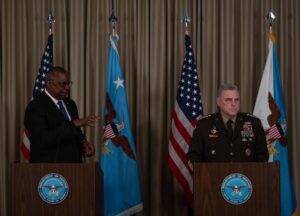Along with a new $675 million weapons aid package for Ukraine, the U.S. State Department announced Thursday it will provide $2.2 billion in foreign military financing (FMF) to Kyiv and 18 other European nations.
Ukraine will receive $1 billion in FMF funds to address long-term military investments, while the department noted the rest will go to help bolster the security efforts of NATO and regional partners “who are most potentially at risk for future Russian aggression.”

The FMF funds are slated to go to Albania, Bosnia and Herzegovina, Bulgaria, Croatia, the Czech Republic, Estonia, Georgia, Greece, Kosovo, Latvia, Lithuania, Moldova, Montenegro, North Macedonia, Poland, Romania, Slovakia, and Slovenia.
The State Department said the move will help those allies and partners in backfilling their inventories of capabilities sent to Ukraine, with the FMF program essentially providing loans to purchase U.S.-made military equipment.
The new $675 million weapons package for Ukraine, the 20th drawdown of equipment from DoD inventories, includes additional ammunition for High Mobility Artillery Rocket Systems (HIMARS) launchers, four 105 mm howitzers and 36,000 105mm artillery rounds, 100 armored Humvees and delivery of more anti-radiation missiles.
Ukraine will also receive 1.5 million rounds of small arms ammunition, more than 5,000 anti-armor systems, 1,000 155mm rounds of Remote Anti-Armor Mine systems, additional grenade launchers and small arms, 50 armored medical treatment vehicles and night devices, according to the Pentagon.
Both the new security aid package and the announcement of the FMF funds effort arrived on the same day as the fifth meeting of the Ukraine Defense Contact Group, where senior defense officials from around 50 countries met at Ramstein Air Force Base in Germany to discuss the latest efforts to support Kyiv’s fight against Russia’s ongoing invasion and long-term security requirements.
“I’m pleased to report that this contact group is now even more united and resolved to keep up our shared support for Ukraine’s right to defend itself. That means meeting Ukraine’s needs for today’s battlefield, and I’m especially pleased by the emphasis today on positioning this contact group to support Ukraine’s self-defense over the long haul,” Defense Secretary Lloyd Austin said during a press briefing following the meeting.
Austin announced that in the next few weeks the U.S., in coordination with NATO, will gather the Ukraine Defense Contact Group members’ “senior national armaments directors,” most likely each country’s top weapons buyers, for a meeting on how to maintain the supply of aid going to Ukraine.
“They will discuss how our defense industrial bases can best equip Ukraine’s future forces with the capabilities that they need,” Austin said. “And so we all believe that working together, we can better streamline things. We can shorten acquisition times, perhaps work on supply chain issues, learn from each other.”
Bill LaPlante, the Pentagon’s top acquisition official, said Wednesday the department’s plan remains to replenish stockpiles of equipment sent to Ukraine on a ‘one-to-one’ basis, either with current systems or next-generation updates, as the department continues awarding deals to refill its inventories (Defense Daily, Sept. 7).
Austin noted the meeting on Thursday included hearing directly from Oleksii Reznikov, Ukraine’s minister of defense, and Lieutenant General Moisyuk, Ukraine’s deputy chief of defense on the latest battlefield assessments and its updated security requirements.
“It’s deeply meaningful to have them here with us in person as Ukraine begins its counteroffensive in the south, and I want to thank my brave Ukrainian colleagues for sharing their insights from the battlefield,” Austin said. “Right now, Ukraine urgently needs more artillery systems and ammunition. It also needs air defense and coastal defense and other critical capabilities. The United States has stepped up to meet those needs, and I’m very glad that so many of our allies and partners have, as well.”
Last month, the U.S. approved a nearly $3 billion weapons aid package for Ukraine, the largest to date, with the new deal focused on meeting Kyiv’s medium to long-term security requirements with capabilities to be procured with Ukraine Security Assistance Initiative funds and set to be delivered in several months to years (Defense Daily, Aug. 24).